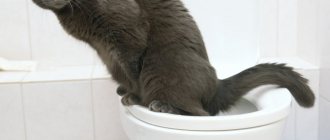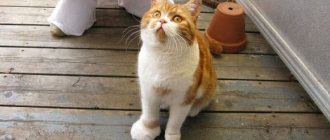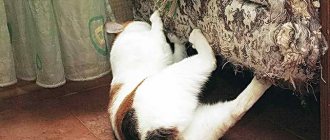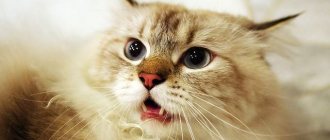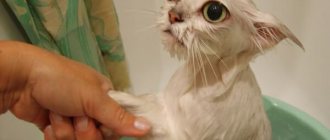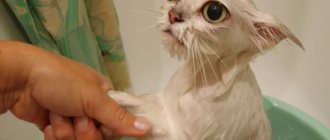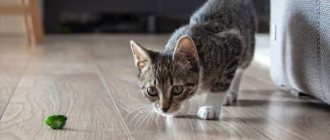Beginning cat owners, when they take home a tailed creature, naively believe that they will be able to combine its presence with the presence of flowers. Once upon a time, the author of the article was so mistaken. Yes, probably about 5% of cats do not show any interest in flowers. But the remaining 95% go crazy at the sight of something natural, green, that they can pick up and bite.
Spray with repeller
As a rule, this is the first advice given to novice cat breeders.
Pet stores sell special sprays, the contents of which need to be sprayed onto the flower, after which it will begin to smell, most likely of citrus. They say cats can't stand this smell. In fact, most cats really don't like it. But this is only the first time until they get used to it. Especially if the owner often eats citrus fruits, the cat gets used to them quite quickly. This does not mean that he will experience a high from them, but this smell may not hurt to torment the flower.
And some cats not only have a normal attitude towards citrus fruits, but even love them. On one of the zoo forums, I saw a complaint from a cat owner who grew lemons at home, but couldn’t eat them: the cat ate everything.
https://fb.ru/post/pets/2020/1/22/177641
https://murkotiki.com/zaschita-tsvetov-ot-koshki
What to do if your cat eats flowers
If a cat eats indoor flowers, then in order to wean him from this activity, which irritates many housewives, you can try different methods. Moreover, all cats are individual; if one method works well for a certain pet, this does not mean at all that it will work for all cats. Let's look at them in more detail:
- If a cat begins to eat indoor flowers, then he will do this until he finds a more suitable alternative for these purposes. To meet his needs, you can get special grass, for example, oats, wheat, barley, millet, catnip. Cats often switch to this type of greenery growing in your home.
- In order to wean your cat from eating flowers, you can try placing them out of the animal’s reach.
- In order to wean your cat from eating flowers, you can add objects with strong odors to the pots. Citrus peels placed in a pot are well suited for these purposes. Especially cats, with their delicate noses, cannot stand the smell of lemon peels. Instead of citrus peels, you can put cloves of garlic or onion in a flower pot. Also, if you treat the edges of a flower pot with vinegar, then it will not go near it for a long time, since this smell is quite pungent for the animal. To repel with smell, you can try using any perfume, because not everything that people like will appeal to a cat.
- If a cat has ever used a potted flower to go to the toilet, then it will be quite difficult to wean it off, because the smell of urine will attract it again and again. If you use commercially available repellent sprays, this can have a bad effect on the flowers. You can try scattering shells and pebbles on the surface of the earth in a flower pot. You can use fiberboard sheets, cut in a semicircle and placed deep into the pot. This will take away the smell of earth that is so attractive to the cat.
- If your cat eats flowers due to a lack of vitamins and microelements, then you can try to balance your pet’s food. It would be good to introduce carrots, cabbage, parsley, cucumbers into it, which will not only help preserve the life of indoor flowers, but also introduce iodine, vitamins into the animal’s body, and will also help in the fight against helminths. Which vegetable your pet will prefer can only be determined by trial.
Citrus
It is a well-known fact that cats cannot stand the smell of citrus fruits. When the owner takes hold of the orange, the cat immediately disappears. Why does this happen? The peel of citrus fruits contains essential oils and when pressed they release and splash to the sides. Cats have a very sensitive sense of smell, so such odors are very pungent and unpleasant for them.
To stop your cat from climbing into flowers, simply soak cotton wool in freshly squeezed citrus juice. Essential oils are not suitable here; it is important to use only natural juice. Wet cotton wool should be placed in a pot. The smell will scare away the cat, and he will not stick his nose into the pot. If the smell is lost, the cotton wool needs to be changed.
Ingenious lifehacks for cats
Let's look at the most popular inventions that help animals and owners coexist:
Scratching posts made from scrap materials
In the same way, the ubiquitous beast is weaned from walking on tables and shelves.
In addition, to prevent climbing in inappropriate places, the latter are treated with a special solution. Made from water, liquid soap, eucalyptus and lemon oils (ten drops each).
Mustachioed fragrance connoisseurs do not tolerate these odors, so areas sprinkled with the composition will discourage visiting them for a long time.
Tray manipulation
Many owners complain that their cat litter box is unsightly. You can hide the tray by placing it in a box decorated to the taste of a home-grown designer.
Bathrooms placed in a closet do not spoil the appearance (the basic rule for equipping such a place is to ensure unhindered entry for the animal). Thick curtains decorating the entrance also prevent the spread of odor.
Green tea leaves thrown into the tray will get rid of the stench.
A scoop made from a plastic bottle will allow you to quickly remove excrement from the desired area. As a rule, store-bought products are too large and trap excess filler.
This list of life hacks is not exhaustive. With a little ingenuity, an old down jacket will turn into a favorite toy or pouf, and a multicooker container into a sleeping shelter or bathroom. Pencils and balls. Ropes and laminate trims. Packaging materials and adhesive tape. Any little thing will do, you just need to show a little imagination.
Sometimes it may happen that in the cycle of daily hassle of taking care of a pet, you cannot enjoy communicating with it. After all, the many responsibilities that have to be performed take a lot of time. We are sharing simple but effective life hacks that will make caring for your furry pets much easier.
Life hack - a hammock for a cat
Arrange a holiday for your four-legged pet, make a bed in the form of a hammock. For this life hack you will need: a piece of durable fabric, the size of the chair seat, and strong tape, you can also use pieces of wire.
It is necessary to attach pieces of tape 15-30 centimeters long to the corners of the fabric. You can sew them on or use a stapler. If you use wire, you can simply make small holes in the corners of the fabric and pull it there. You should have small ties. Then each tie must be wrapped around the legs of the chairs, approximately in the middle
Next, we tighten our knots tightly; it is very important to tighten them as tightly as possible so that the hammock does not slide down. That's all, you will have a hammock under the chair seat
Not only a chair is suitable for such a hammock, you can also use a stool or a small desk.
Protect your cat from flowers
The question of how to protect a cat from poisoning by poisonous plants is also important:
- philodendron;
- spurge;
- all types of begonia;
- hydrangea;
- crocus;
- spathiphyllum;
- dieffenbachia;
- English ivy and many others.
Pots with such flowers are placed in places inaccessible to the cat - on shelves, flower pots, containers hanging from the wall, etc. If it was not possible to save your pet from eating dangerous greens, and signs of poisoning are noticeable, it is better to immediately contact a veterinarian.
Thus, there are quite a lot of means that will help scare a cat away from plants in the house or in the garden. It is useful to know about measures to prevent such phenomena. To use them, it is better to understand the reason why the cat began to love house flowers. Perhaps he simply does not have enough vitamins - then it is better to buy grass for cats or regularly take special medications.
Colorful, fragrant and such a variety of indoor plants attract the attention of not only their owners and their guests, but also pets. Cats always show a special interest in green and blooming pets.
The presence of furry pets should be taken into account not only when selecting plant species. Some indoor plants will need to be protected from cats with special measures, while others will need to be used wisely.
How to protect indoor plants from cats?
Use wall planters
You can keep plants in wall planters. These devices look like round plates. Mount them high on the wall and your flowers will be inaccessible to animals.
Remember that not all plants can be grown in wall planters. This method of maintenance is suitable for unpretentious species (succulents) with hanging or creeping shoots.
Cat repellents
To combat the excessive love of furry pets for indoor plants, you can use both homemade and special means.
Consultation regarding repellers can be obtained from any veterinarian or pet store. Today, along with a wide variety of pet care products, they also distribute a special spray that repels cats - with the eloquent names “Antigryzin” or “Antigadin”.
This “cat repeller” often contains natural substances, including essential oils, the smell of which cats perceive as unpleasant and repulsive. Animal repellents are intended either for home gardens or indoors. But if you choose the wrong type of products, you can significantly spoil the atmosphere in the room.
You can cope with the task of scaring away cats using other methods.
Using plants that cats cannot tolerate
After observing your beloved pet for some time, you can notice which plants the cat does not like (often these include representatives of the bulbous family, indoor citrus fruits or aromatic herbs). By growing unloved crops in small containers, you can surround the best plants in your collection with them, protecting them from cats.
Using deterrent odors
Cats cannot stand the smell of alcohol, ordinary table vinegar and all citrus fruits; sometimes they seem to react to the aroma of black, allspice pink or hot red pepper. Using citrus essential oils or natural essences, alcohol infusions and even fresh peels, you can create a natural “repellent” from indoor plants.
Soaking cotton wool in alcohol, essential oils or vinegar is a temporary measure. As soon as the smell evaporates, the product will stop working, so such traps always have to be renewed.
Using scrap materials
Using sticky, rustling materials or remote control toys to repel young cats. Double-sided tape, rustling foil or cellophane, small cars placed around indoor plants to scare away sounds or unpleasant experiences, these methods are controversial and require an analysis of the preferences and whims of a particular cat.
Of course, to scare away plants with a machine, you need either a passionate assistant or a lot of time. But both methods are excellent alternatives if conventional means do not help.
The soil in the flower pot is protected with toothpicks from being torn by a cat.
"Cat problems" of plants
Cat owners often complain that their furry pets eat their houseplants.
But there are also other “cat problems”: indoor plants attract the attention of cats, they simply play with plants or with the soil in pots, digging, turning over containers, crushing greens and picking flowers, and sometimes they just lie on certain plants. Mischief and overeating are different phenomena, and they also need to be dealt with in different ways.
Cats' attention to plants and eating their leaves is often explained as a lack of vitamins or a sign that it is worth reviewing their diet. But when it comes to analyzing the reasons that prompted furry pets to pay attention to indoor plants, you should not trust myths and rumors
Cats eat indoor plants for only one reason - they lack coarse plant food, which speeds up and simplifies the process of regurgitation of hair.
Indoor plants for cats are actually a substitute for grass. If your pet enjoys walks in the fresh air in the summer, then his love for indoor plants completely disappears, but in winter it manifests itself in almost all cats.
It is easy to understand the mechanisms that lead to eating indoor plants if you analyze the range of plants that attract pets. Cats love cereals, and often look for a replacement for them among plants with hard leaves, not only among ornamental grasses, but also palm trees with their feathery fronds, and even Kalanchoe.
Cats can play mischief with any indoor plant. From gorgeous, beautifully blooming indoor roses and Saintpaulias, growing seedlings, large palms and vines, to modest indoor aloe succulents and even window-sill green onions, sometimes cats' preferences seem quite bizarre and atypical.
Correct behavior of cats and their owners
The first and main means of “peaceful coexistence” of cats and indoor plants is proper training and behavior adjustment. Tray training, rewarding for correct behavior and ignoring indoor plants are the best ways to prevent any problems.
Do not confuse rewards and training with punishment: even if a cat breaks your best flowerpot or destroys your favorite palm tree, never use scolding, screaming or physical violence as a method of dealing with the problem. Cats react negatively to punishment; it makes the problem worse. But encouraging correct behavior and gentle training work reliably and always.
When teaching your cat that it is wrong to play or eat houseplants, don't forget that cats who have nothing to do or are stressed and anxious can be mischievous. Spend time with your pets, provide your cat with toys, use special programs, do not block access to windows and observation of the outside world - and you will achieve your goal sooner.
Of course, there are direct means of combating this problem. But they will never replace proper treatment of a cat.
The cat eats a houseplant. Mick Telkamp
Sticky or rustling materials
Some housewives think that by closing the window with curtains, they blocked the cat's path to the windowsill. Actually this is not true. The cat will get to the pot quickly, and you will not be able to admire your favorite plant with the curtains closed.
Alternatively, you can spread foil around the flower pot. Cats love to play with this material, but are afraid to step on it. You can also use double-sided tape. Having first removed the top layer from it. True, there is a small drawback when using this protection option. Cats are agile creatures and can easily jump over obstacles. Therefore, the barricade will have to be erected over a large area.
Proper organization of plant collection
Proper placement of indoor plants that attract cats is the main means of combating overeating, soil undermining, and other cat pests. It is necessary to organize the coexistence of domestic plants and animals so that contacts are reduced to a minimum in a natural way.
The simplest option is to place the plants that the cat loves higher up, in hard-to-reach places - but it is also the most controversial. Firstly, hard-to-reach places or high placements are not always unattainable for cats, which can climb to any height and overcome any obstacles. Secondly, not every place will be comfortable for the plant itself - both in terms of lighting level and access to fresh air or temperatures.
But there are several rules for plant placement that will help minimize potential harm:
- It is better to place indoor plants on the walls or hanging;
- you need to choose heavy, stable containers for plants that are not easy to turn over even for an adult cat;
- It is better to prefer alternative options to placement on the windowsill, and if this is not possible, organize the collection so that there is more free space on the windowsill (some of the plants can be placed on racks or hung as ampels);
- Any racks and stands need to be additionally secured so that they are not only reliable, but also stable.
If your cat particularly likes some plants, it is worth choosing more reliable methods, taking into account all the disadvantages of conventional methods. True, the options for protecting plants from among cat's favorites are quite limited:
- Protecting plants with decorative fences or walls.
- Placing plants in florariums and flower displays (only for people from the humid tropics).
- Placing plants in niches or on racks with additional safety bars or grilles.
Place covering material on top of the soil in the pot. Carrie Higgins Decorate the covering material in the pot with burlap. Carrie Higgins Place the plant pot, covered with burlap, in a decorative planter. Carrie Higgins
Use hanging planters
You can use hanging pots. This will help you keep plants away from animals. Try to hang the pot high enough so that the cat cannot reach or jump to the flower.
Separated work from life: why Justin Bieber put his phone aside
Why did Pushkin consider envy a good feeling and did not condemn it, but encouraged it?
You should forget about entertainment: what other restrictions does Lent have?
You can also place the pots in macrame planters and hang them from the wall or ceiling. But make sure that the wicker product does not contain hanging decorative elements. Otherwise, the cat will start playing with them and throw off the potty.
Hanging planters keep plants out of reach of animals. But it cannot be ruled out that leaves and flowers will end up on the floor and the cat might pick them up. Therefore, you need to give preference to safe and non-toxic plants.
How to protect flowers from a cat?
Application of essential oils
In some cases, to protect flowers from cats, it is recommended to use various essential oils, the odors of which are not particularly pleasant for pets. These include the smells of orange, lemon and peppermint. Add a few drops of oil to a small container of water and spray the resulting solution onto the plant. Such irrigation will not harm the flower, but may become a deterrent for the cat.
However, it is worth remembering the uniqueness of these animals, because for some of them such a perfume can become an attractive factor. Therefore, it is worth checking in advance what exactly your pet does not like, and what he will be incredibly happy about.
Use of herbs
A similar method with essential oils is herbs. To do this, you need to plant lemon balm, lavender, sage, oregano or mint next to the plant. That is, other plants that emit a pungent odor that prevents the cat from approaching the flower pot. In addition, the presence of spices in the kitchen will never be superfluous.
Hotness of pepper
Another method of “fighting” cat tendencies is the use of hot pepper. To do this, add a teaspoon of red hot pepper to half a glass of water and mix everything well. The resulting solution is carefully sprayed onto the plant and the pot itself.
Alternative cultivation
In nature, there are many plants that are easy to care for and uninteresting for cats. One of these is the succulent. This plant is not only hardy, but also absolutely not of interest to four-legged animals. All they can decide to do is sniff its leaves. Moreover, some varieties of succulents have natural protection in the form of small spines.
Create uncomfortable conditions
Some gardeners recommend spreading foil on the surface where the flower slides stand. The cat will slide along its surface, and, in the end, it will get tired of this activity.
But if the animal shows genuine interest in the plant, then it is unlikely to be stopped by foil flooring. Moreover, there is a risk that this will be a new pastime for the cat, and regular rustling may be added to its mischief with the flower.
The higher the better
The simplest and most accessible method of saving flowers from a cat is to place the pots in places inaccessible to the animal. First of all, we are talking about high shelves or hanging structures. Of course, this option is only acceptable if the size of the flower pot allows it.
Shells
In some cases, ordinary seashells come to the rescue. They can not only decorate a flower pot, but also protect it and the plant from an annoying cat. Shells are purchased either at a pet store in the aquarium fish section or collected by hand. Some animals do not like their smell, and if the shells are placed randomly (smooth surface upside down or upside down), then not every animal will stand on them with its paws.
Terrarium
You can purchase a plant terrarium that opens from the side. This accessory will completely protect indoor flowers from animals. But it is important to remember that not all species can be grown in a closed terrarium.
Succulents are not suitable for growing in a terrarium. They do best in open containers. It is better to choose plants that tolerate high humidity well. After all, the terrarium develops its own ecosystem with a certain level of moisture. Species such as nephrolepis, dwarf ficus, begonia, pilea, and mini ivy are ideal.
Spiny plants
You can plant cacti in your home. It is believed that these plants are able to protect themselves. After all, thorns repel most adult cats. However, if you have a small kitten living in your house, then it is better not to grow plants with thorns. Children do not always realize the danger and can get hurt on sharp thorns.
Judging by the reviews of cat lovers, this method does not always work. Many owners report that their pets eat and chew cacti. This plant does not contain toxic substances, so there is no danger of poisoning. Most often, cats that lack water show interest in cacti. After all, the fleshy, prickly stems accumulate a lot of moisture.
Spread with pepper
A similar, but cruel, method is to spray the flower with pepper spray. The expectation is that one day the cat will taste the leaves of the plant and will never do it again.
This method is barbaric, because the animal will feel very, very bad. In addition, if you have children at home, they too can try the flower. I know what I'm saying because I did it myself as a child. Moreover, after I touched the pepper, I rubbed my eyes. The pain and burning sensation were unbearable.
Article continues after advertisement
What harm can a cat do to flowers?
Yes, a lot of things. If the size of your “flowerbed” allows it, then she can lie down there to rest, crushing the entire plant. It may begin to dig the ground and eat it along with the roots. May bite and scratch the crown. Or maybe just gobble it up.
Cats also have a wonderful habit of peeing and even pooping on flowers. And what? The place is excellent, natural, you can bury it, and you get fertilizer for the plant. But then this plant doesn’t smell like flowers at all...
A cat's natural instinct awakens when it comes into contact with plants. Moreover, as experience shows, even if the flower is conditionally poisonous, this usually does not bother the murkotik. As a result, even your cacti are at great risk.
Many people believe that a cat can be taught not to touch flowers using prohibitive words or actions. This works on very docile cats, but not on most cats.
Basically, they prefer to either ignore the owner’s requests, or do their dirty work in his absence, or even, on the contrary, use the flower as a method of manipulation: they say, you don’t want to play with me and pay attention to me, but what about you if I start the flower? eat? At the same time, they stealthily glance at you, whether you notice or not. And my pet generally, if I don’t notice, will also let me know with her voice
But smart people have come up with several solutions to keep your flowers safe from your cat, even if he doesn't want to listen to you. We share other people's and our thoughts on this matter.
Erecting obstacles
If the animal does not chew leaves, but simply digs the ground and bites the roots, you can simply place large pebbles, crushed stone and other heavy stones on the surface of the soil. However, it will be necessary to loosen the soil more often, otherwise the flower will begin to develop worse due to the lack of oxygen reaching the roots.
There are other methods of protection:
- You can simply put the plants in a hard-to-reach place: this is the most effective protection of flowers from cats, although, unfortunately, it is not always possible in a city apartment.
- If space allows, you can make a small flower garden: fence off all the plants by erecting glass partitions. With the help of effective lighting, such a “room” will decorate the house well and fit into almost any interior.
- Interestingly, some flowers can also be hidden in a special glass flask (purchased in a special store). As a rule, cacti are protected in this way. A small stone is poured onto the ground, which creates the impression that the flower is growing in an “aquarium”.
Protecting the soil from being torn up by cats
Cats are often attracted not so much to the plants themselves as to the soil in the pots. Digging in the ground for sanitary purposes or for fun is a great pleasure. But any such tearing turns into disaster for the plants themselves and everything that surrounds them. Large pots and tubs are especially attractive to fluffy ones. It is believed that cats picked up from the street most often undermine the ground, but this is rather a theory and a question of the quality of the cat’s training.
There are several ways to deal with the problem of soil tearing:
- use heavy or dense mulching materials - cones, large shells, heavy stones or coarse gravel;
- combine decorative mulching with repellent odors;
- cover the soil surface with a metal or plastic mesh;
- use special protective grilles.
Homemade repellent
Citrus peels can be successfully replaced with essential oils. Just dilute a few drops in water and the cat repellent is ready. To enhance the effect, the mixture is sprayed in the air next to the plants, or you can sprinkle the soil in the pot. It is necessary to ensure that the liquid does not get on the plant itself.
IN THE PHOTO: A small container with a spray bottle is perfect for storing cat repellent
To prepare a spray to save flora, you need to mix:
- 60 ml. water;
- 2 drops of lemon essential oil;
- 2 drops of wild orange essential oil;
- 2 drops of lavender essential oil.
Safe Swimming
Bathing dogs should be done with great care, because water entering the ears can be harmful to the pet's health. A regular shower cap placed on a dog's head will help protect ears from moisture.
Every cat owner will agree that such a pet is not only entertainment and an escape from loneliness, but also a full member of the family, who, like others, needs care and attention. He also needs various devices that will help make life more joyful and comfortable. This does not require large expenses; you just need to know the basic habits of the animal in order to protect yourself from damage to furniture or other troubles. How can you help a cat so that he doesn’t get bored and doesn’t “clean up the mess” or damage his property to pass the time? Thanks to simple and useful life hacks for cats, you can stop your pet from climbing flower pots, and also organize a place where your pet can retire if desired.
The tricks discussed below are very simple, but they will improve the life of your pet and make coexistence more harmonious.
Puzzle
Cats love to get various objects out of hard-to-reach places, so they will certainly appreciate a box with a “surprise” from a food container: to do this, you need to cut several round holes in it with a knife, and place small bright toys or treats inside the container. The main thing: do not forget to melt the edges of the holes with a lighter so that your pet does not injure his paw on the rough and sharp plastic
The animal’s attention will be attracted by such entertainment for a long time, so he will not leave it until he has “scratched” all the objects
Observation post
Cats love to watch everything that happens outside. To make this process more comfortable, you can place a box on the windowsill or make a special lounger - attach a tray or shelf with a thin pillow to the windowsill. Another option is to use a stepladder for these purposes, where the pet can sit comfortably and watch what is happening on the street.
Cleaning wool
If the cat is not a representative of the “hairless” breed, then every owner is familiar with the problem of hair all over the house firsthand. To reduce the amount of cat hair that constantly collects on the floor and furniture, you need to comb it every morning or evening. And to quickly remove this very wool, just walk your hands in rubber gloves over your clothes, sofa and other surfaces - all the hairs will easily stick to the glove and removing them will not be difficult.
cat house
Almost any cat will be interested in a bright and compact house in which it can hide from its owner to relax or play. To make such a “shelter”, you need to spend literally 10-20 minutes of time and first prepare a couple of wire hangers, cardboard and an old T-shirt. In this case, it is advisable to take a larger T-shirt so that your pet will certainly have enough space in the new house. Detailed instructions can be found in the video below.
Forbidden places
As you know, cats are not very trainable, so it is quite difficult to instill in them where they can and cannot go. But this can be done with the help of natural instincts - cats are very wary of sticky surfaces, therefore, in order to wean your pet from climbing, for example, on tables, regular or double-sided tape is useful, which must be stuck on forbidden areas so that the cat will forever forget the way to them .
Water treatments
Almost all cats are terrified of bathing, and one of the reasons for this is the slippery surface of the bathtub or bowl, on which the animal feels insecure due to its paws moving in different directions. But it is enough to lay a towel on the bottom so that the pet can calmly and confidently withstand all water procedures, while the owner remains unscratched.
Another option is bathing in the sink, since large volumes of the bathroom can frighten the animal and it will try to leave this space as soon as possible. But in the sink it will be easier for the owner to hold him and wash him, and the cat will feel more comfortable when the owner is close, and not hanging over him from above.

